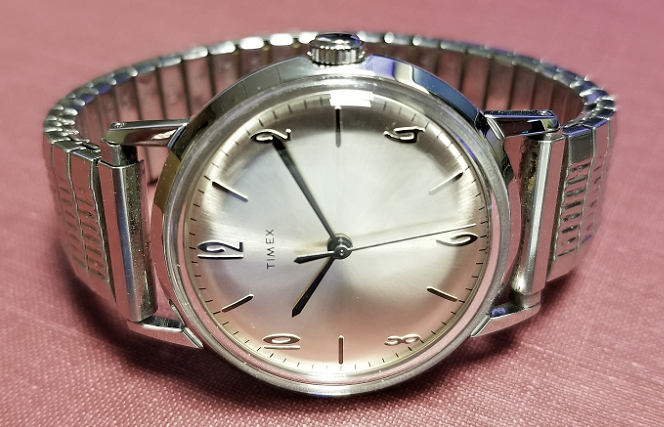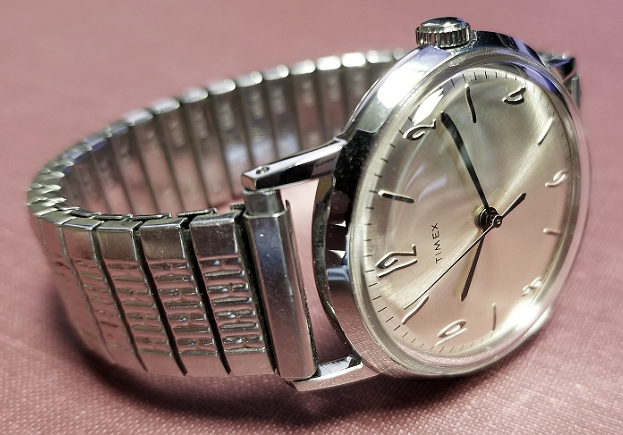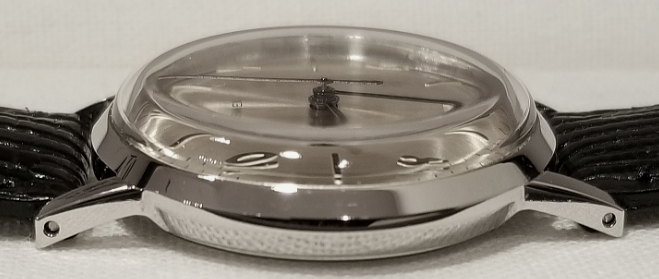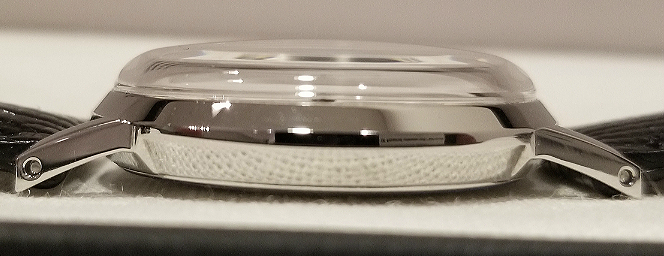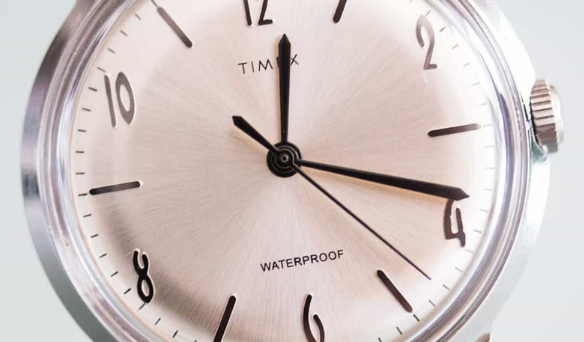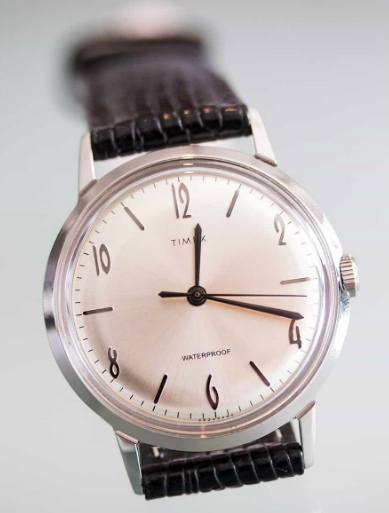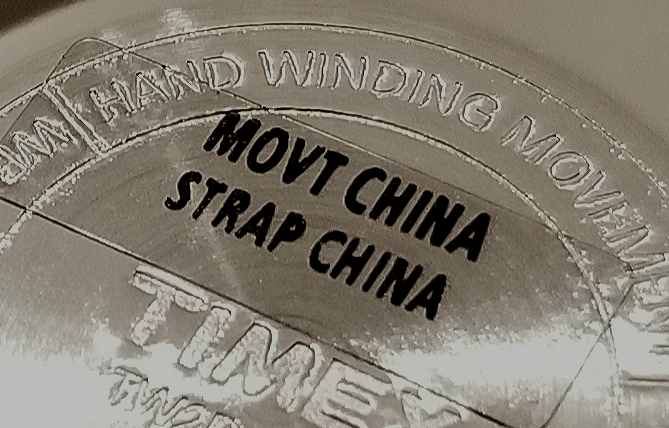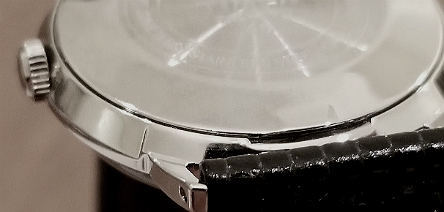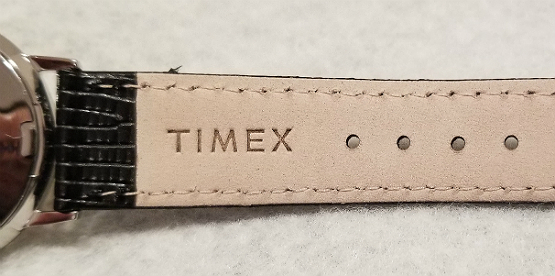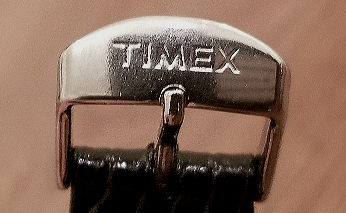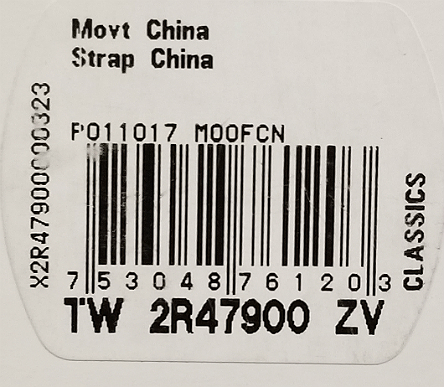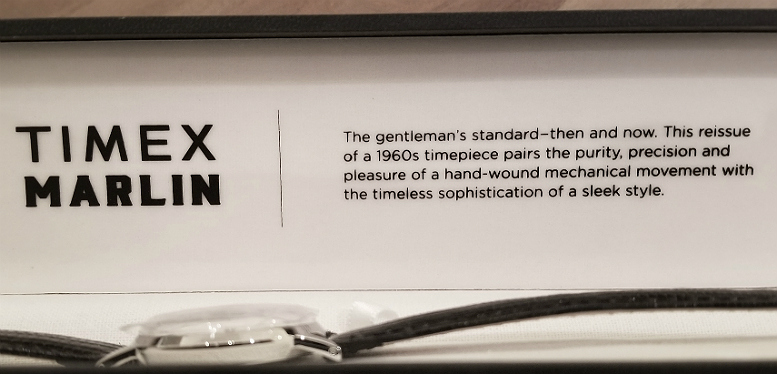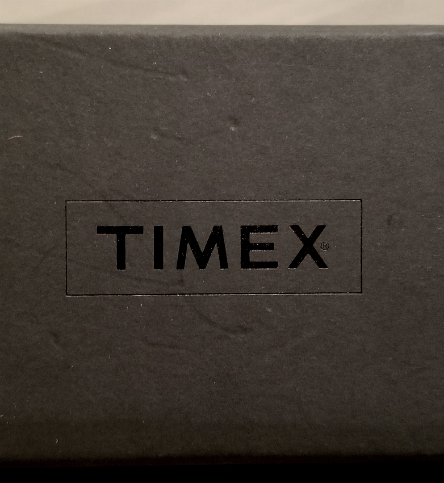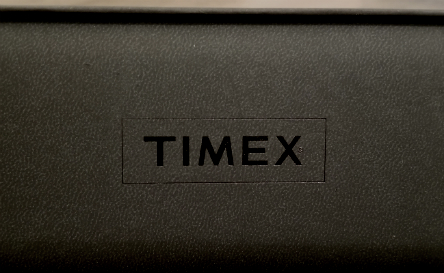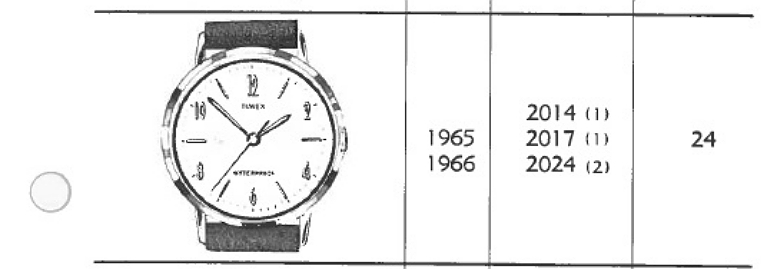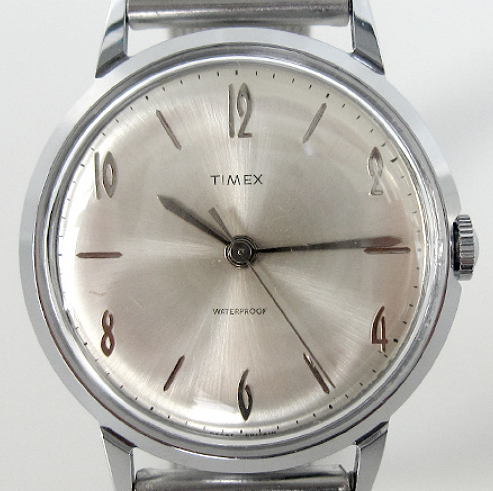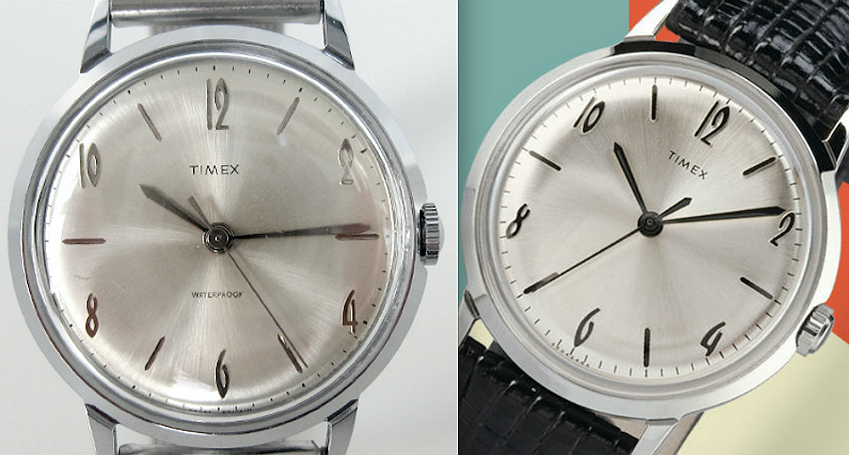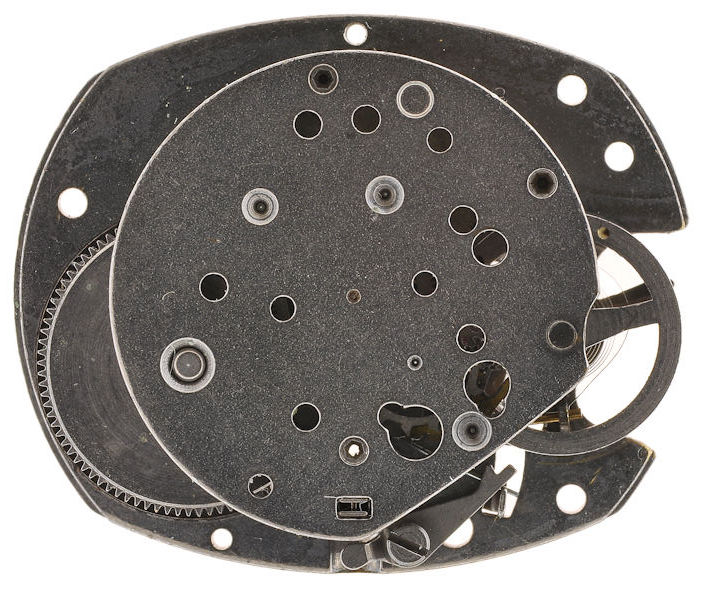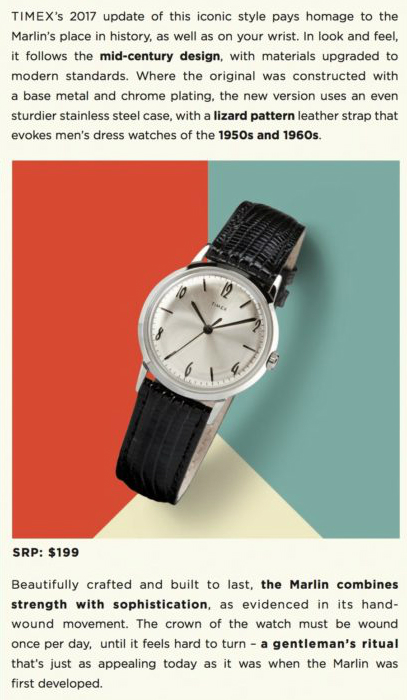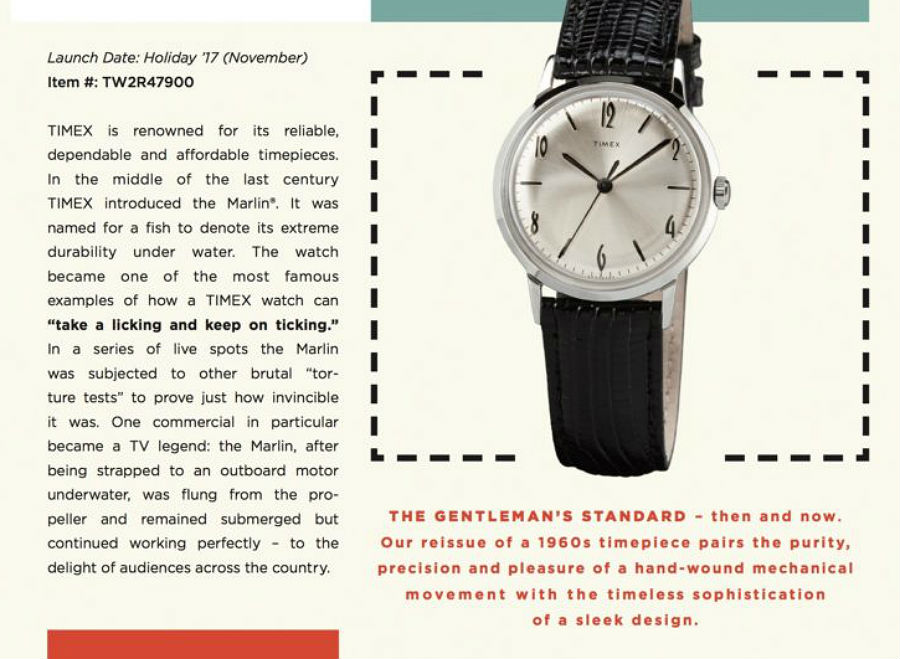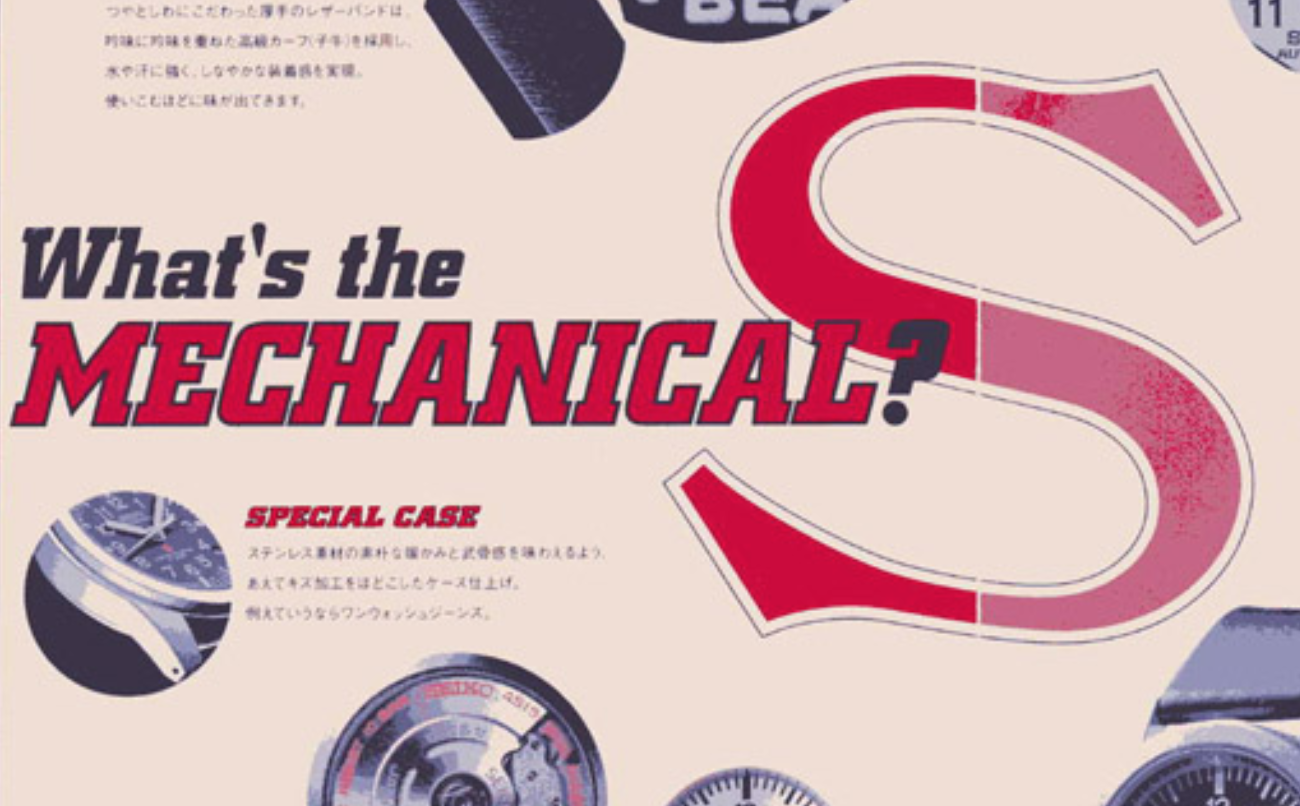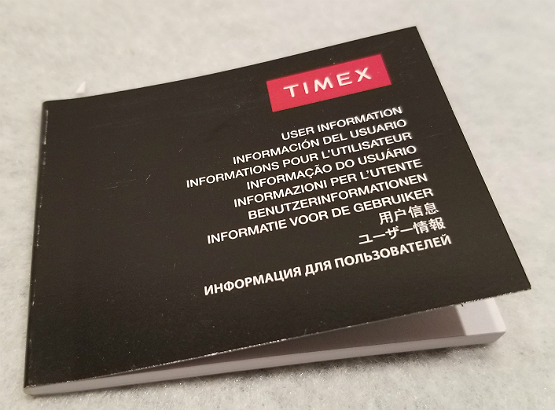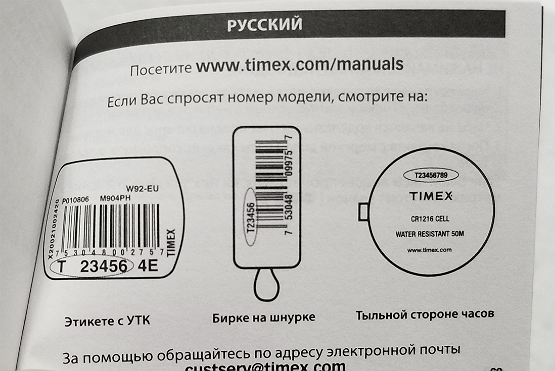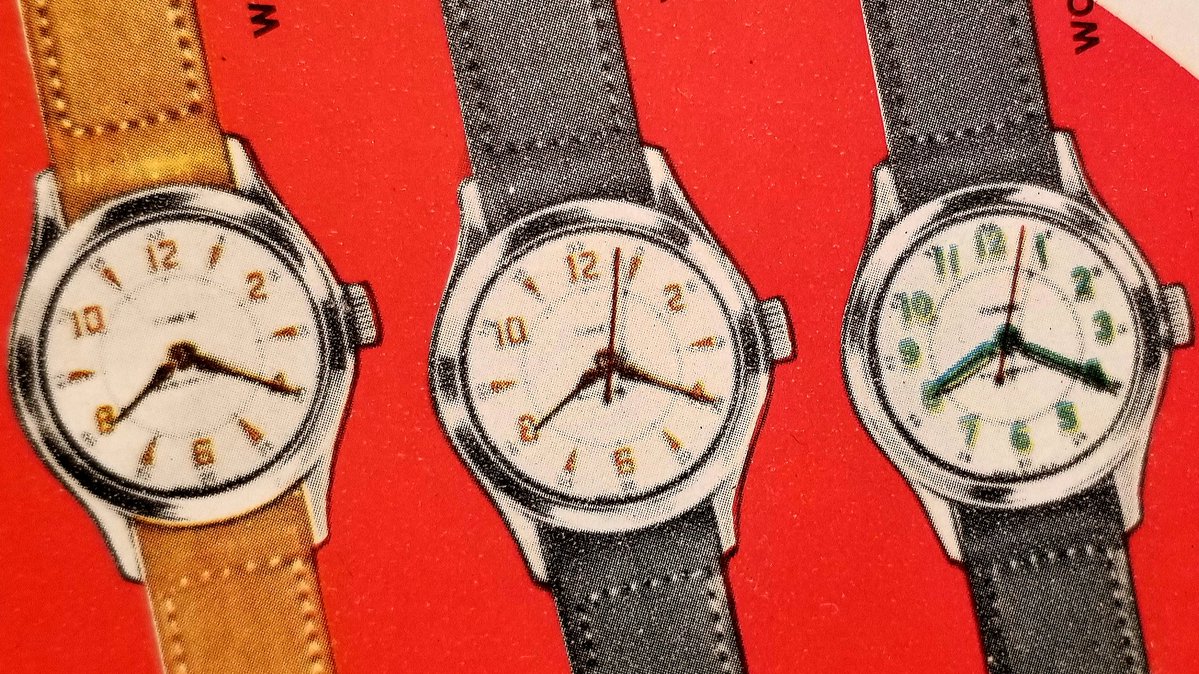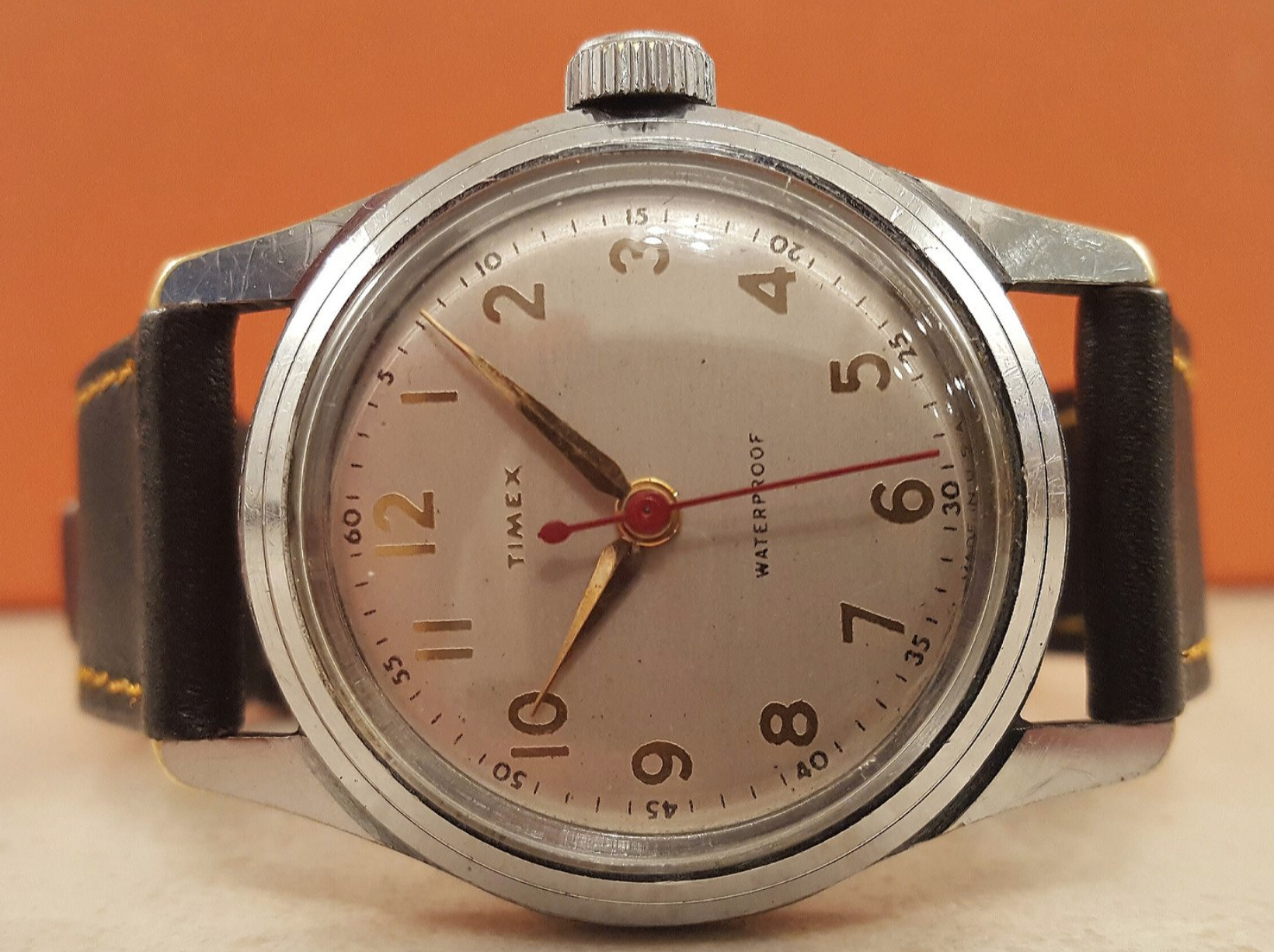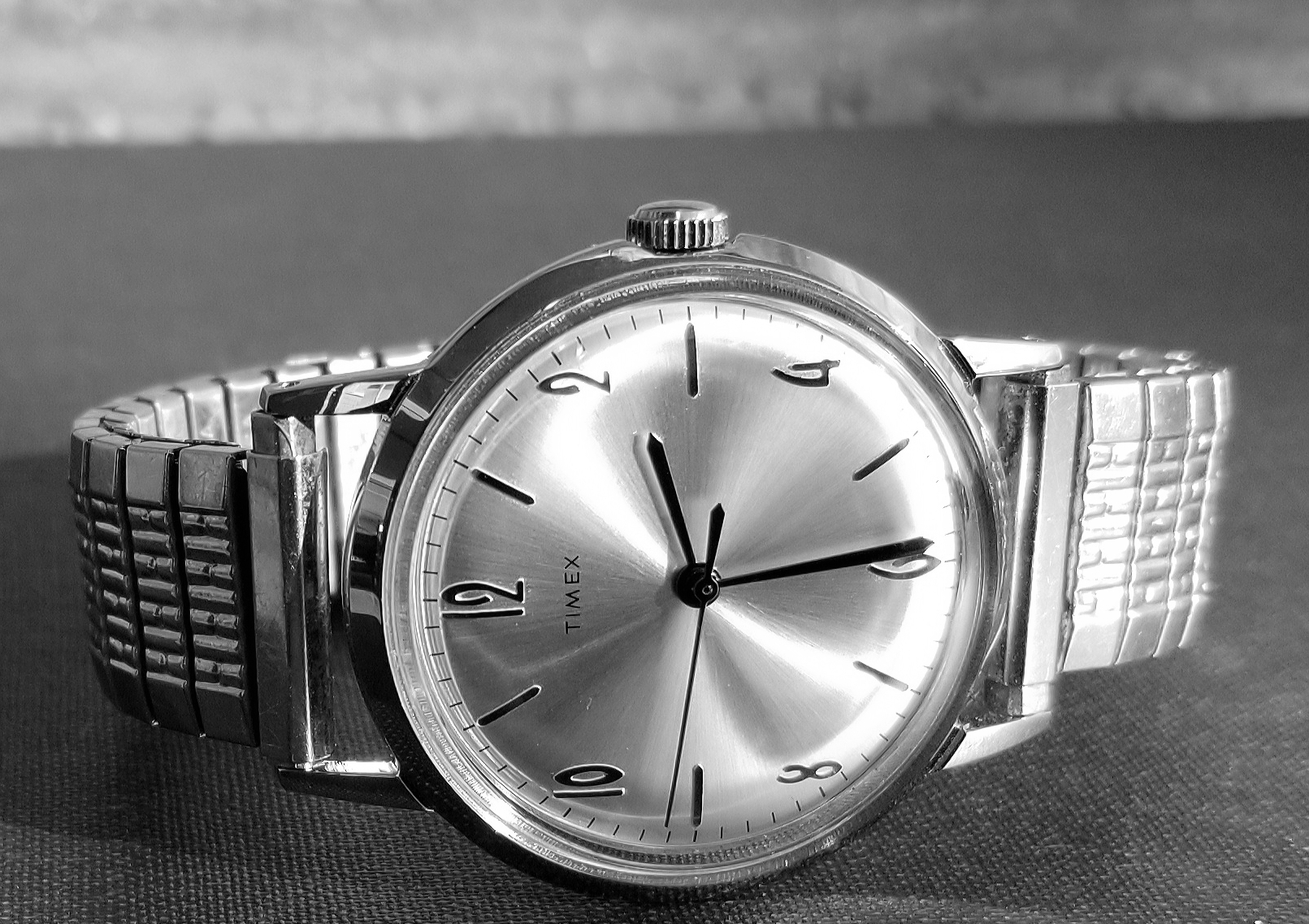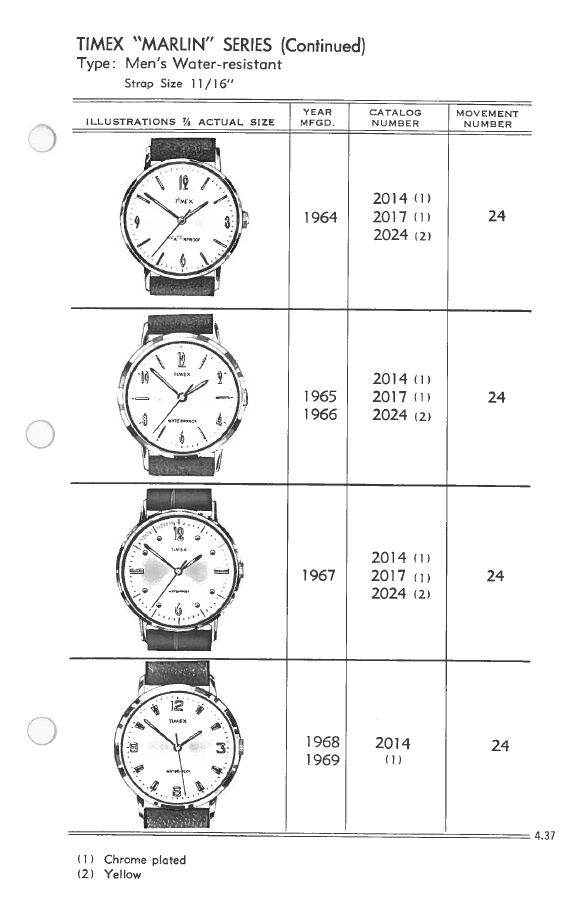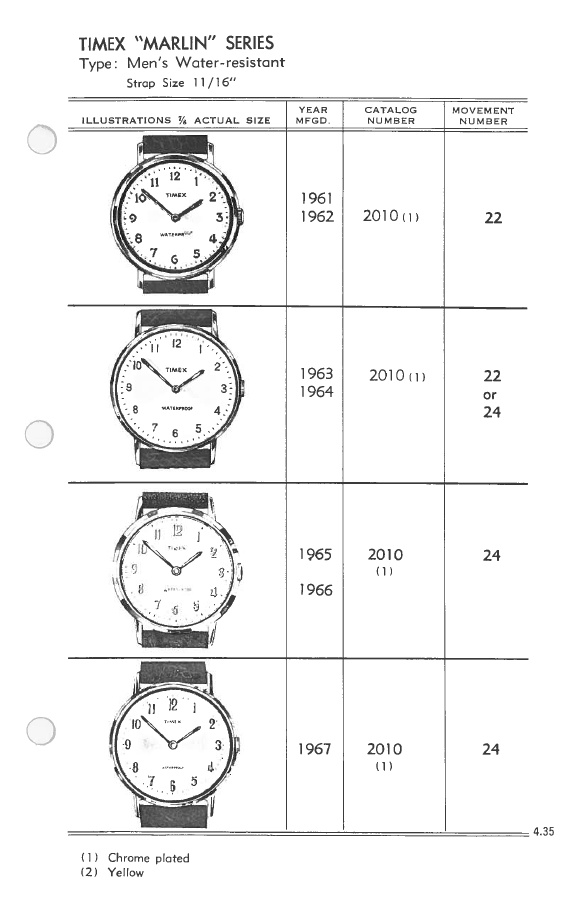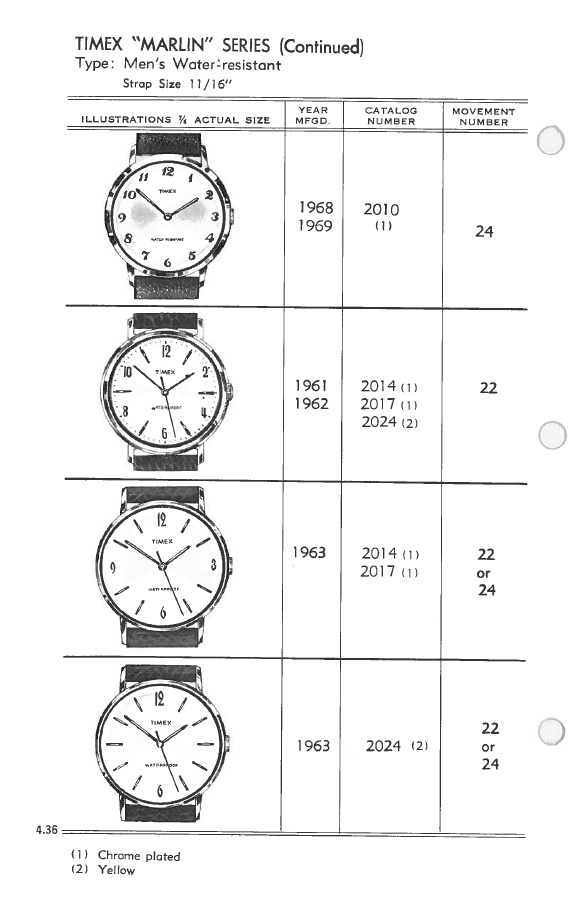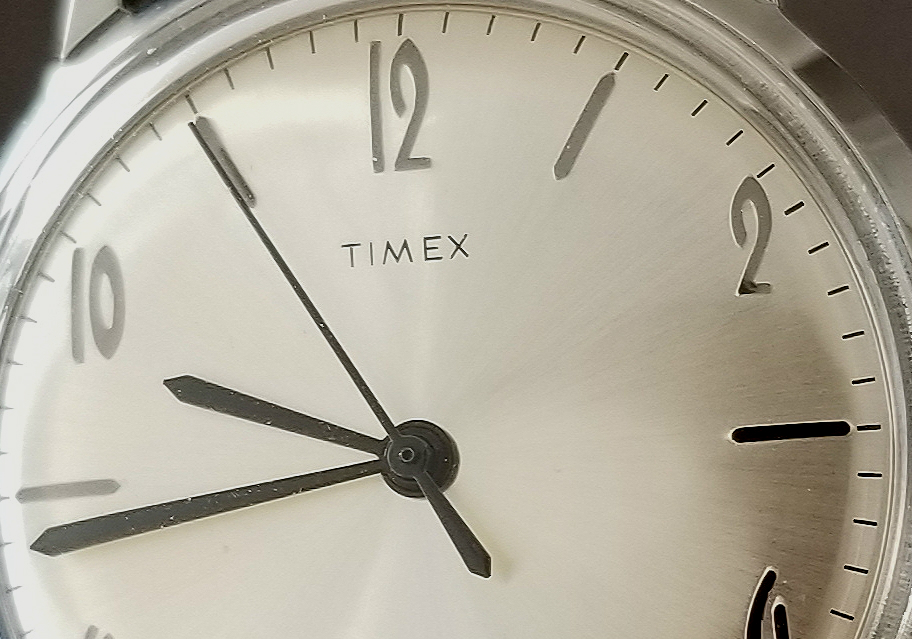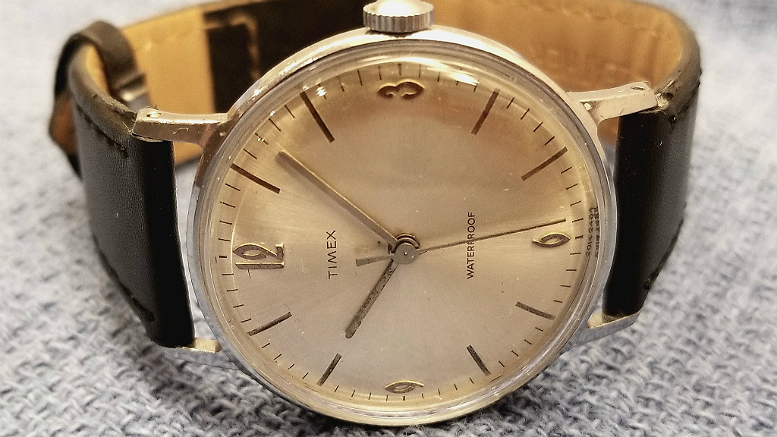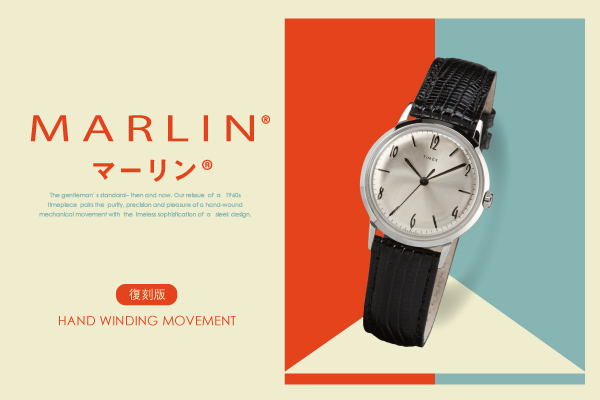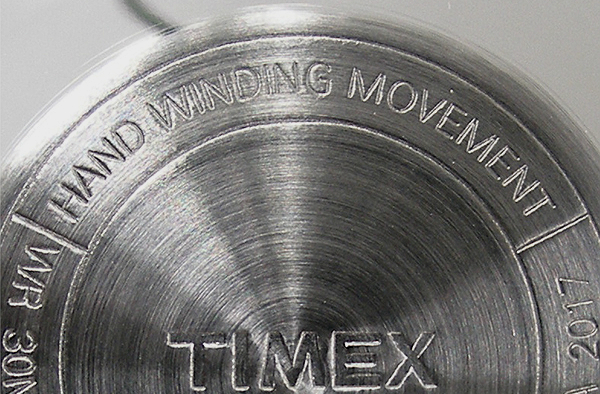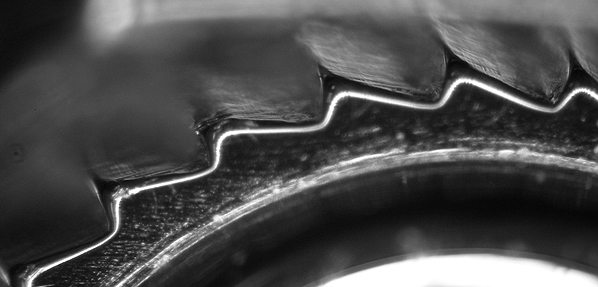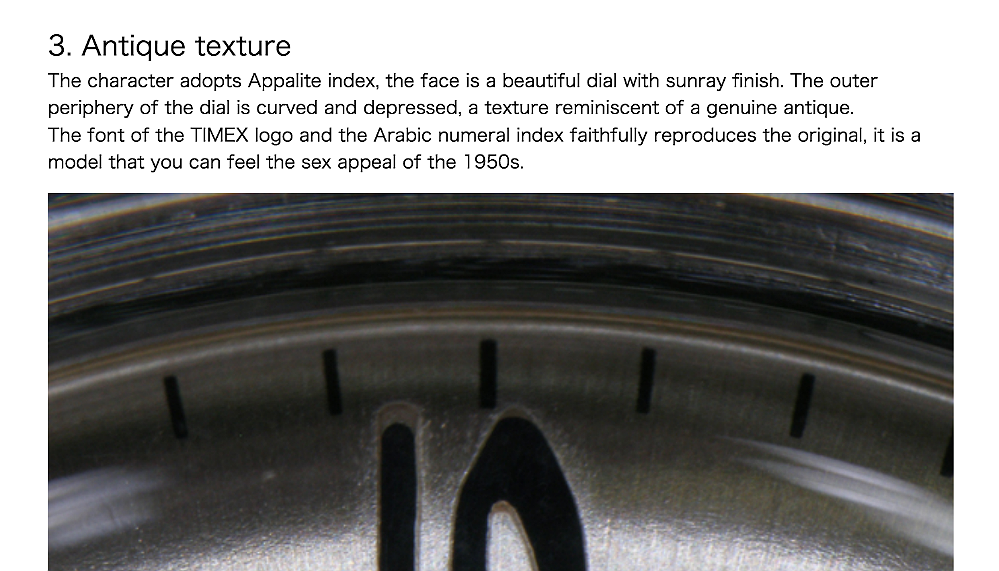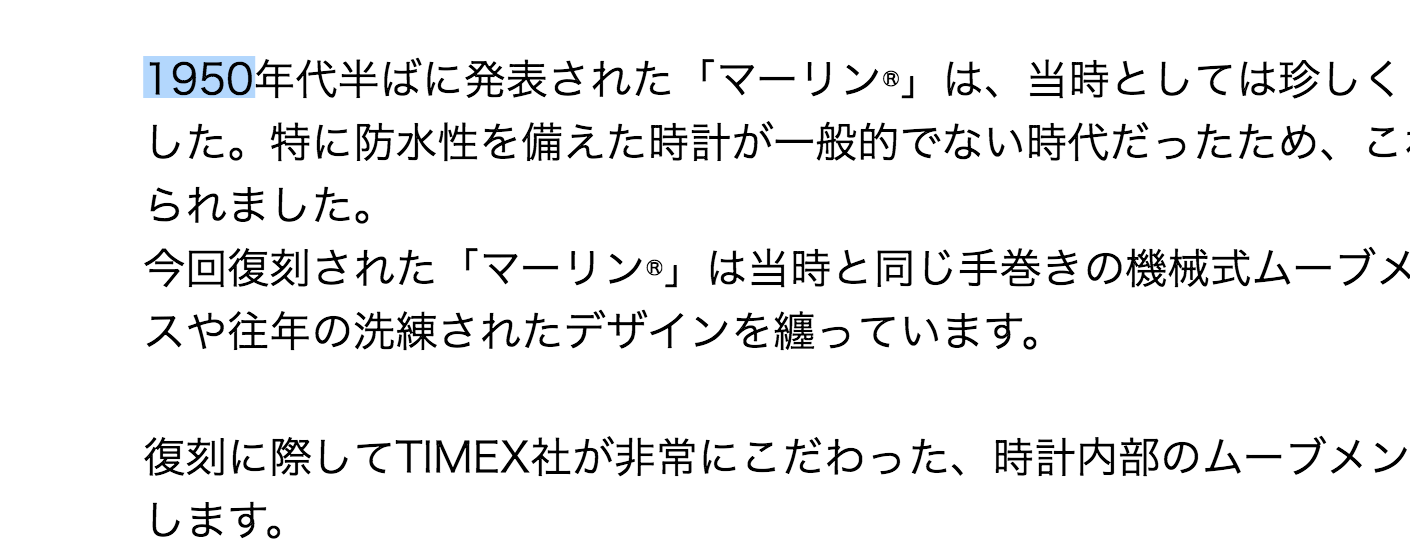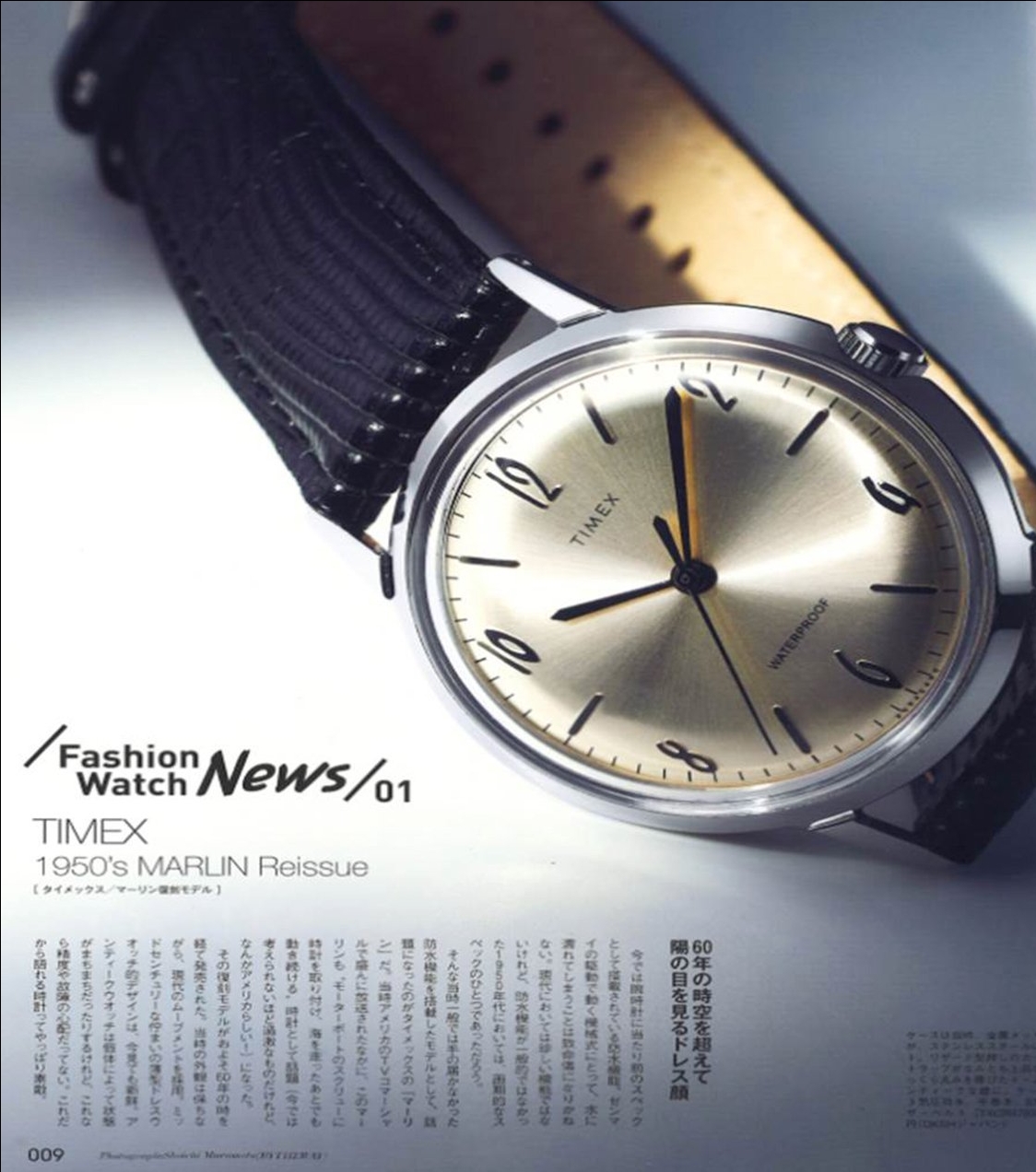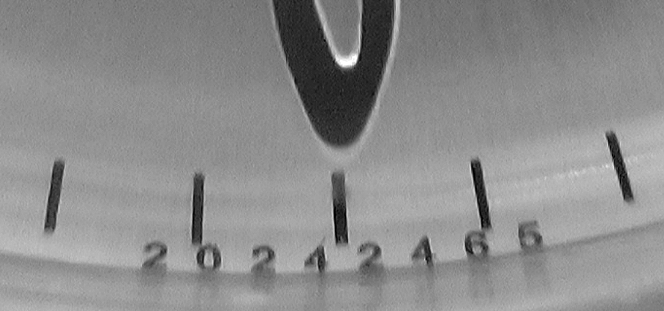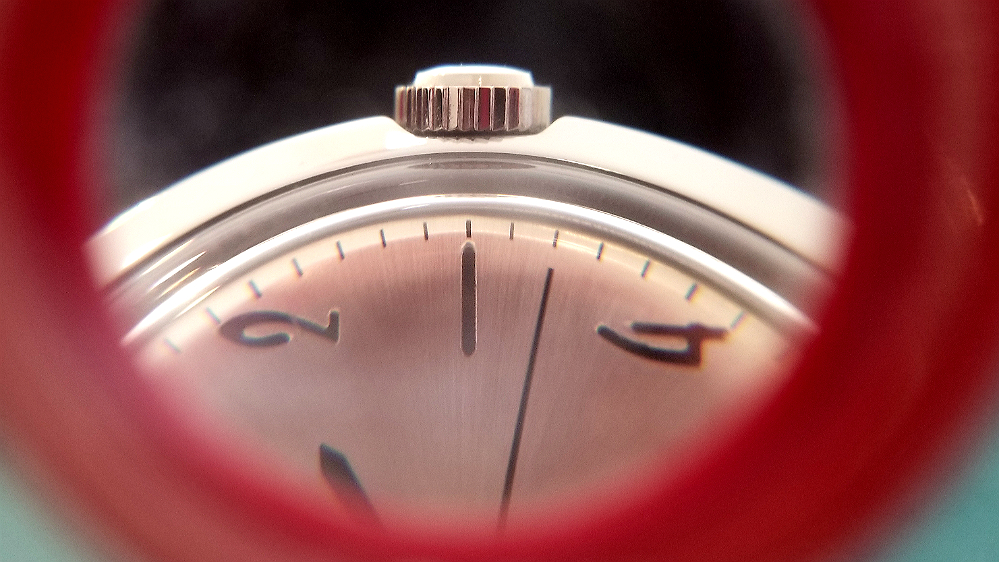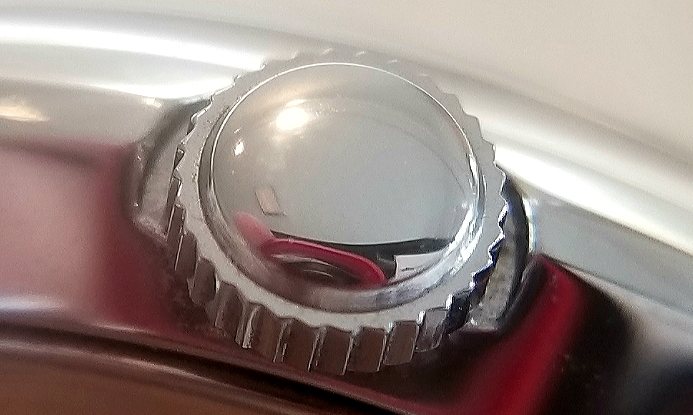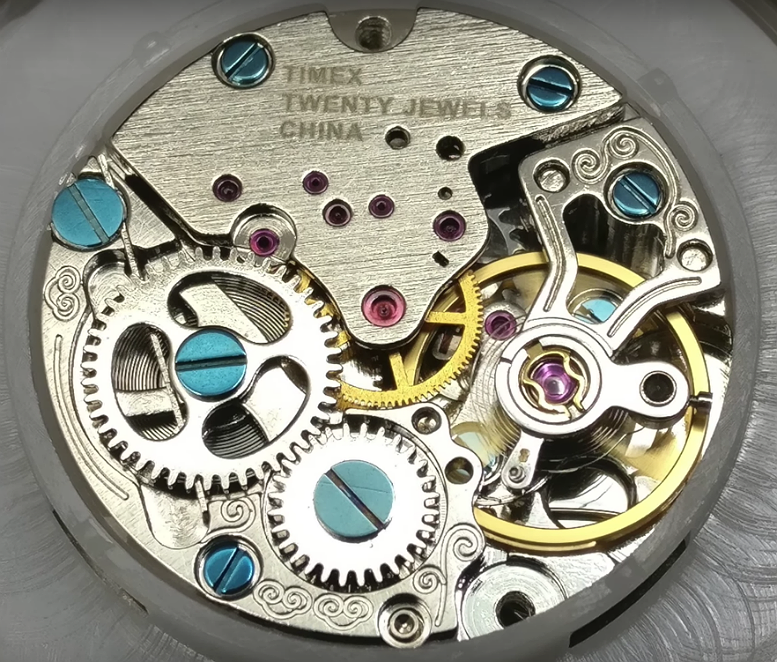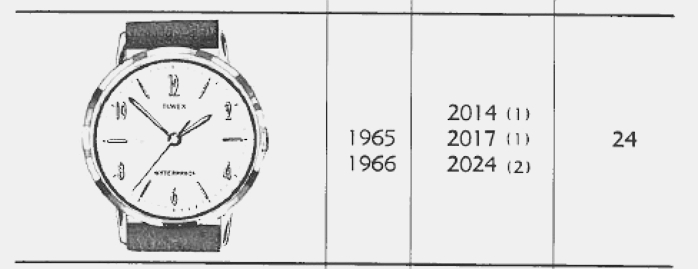TIMEX Marlin Reissue - Mechanical Timex, 2017
Hi once again. Here is my review of the lovely Timex Marlin Reissue. It is a mechanical watch, the first mechanical from Timex since ca. 1996, and is based on the above pictured Timex model 2024 from the repair catalog, 1965-1966. (Many models were called "Marlin." For repair catalog drawings from many Marlins from 1961-1969, click here, here and here, or scroll to the very bottom of the page.)
In short, this watch appears to be a very good reproduction of the original, with attention to various details, and appears to be well-built of quality materials. So far, I am liking it very much. This is a very lenghty review with many photos. Includes some "philosophy" about a mechanical Timex far, far below. Will appear best on a computer, not optimized for phone! [NEW: My review of 1964 vintage Marlin.]
The above image of the watch is from Timex promotional materials. This page will contain a few more of these, many pictures of my own watch, along with some photos of original watches from the 1960s upon which this is based. [***For nice pics from TIMEX Japan, on this watch, scroll far below...]
The watch was purchased from designer Todd Snyder New York, from their website. [Todd Snyder has collaborated with Timex to produce numerous wristwatches with quartz movements that appear exclusive to the Todd Snyder store and online. I have one of these, a robust and beautifully made reproduction of a 1971-1973 Timex "Sprite" model. You can see that here if interested. (The original "Bullseye Sprite," upon which that is based, is exhaustively covered, here.)]
In addition to being sold though Snyder, and the various Timex official websites (including US, Canada, and Japan - see further below for some fun TIMEX Japan pics,) it was sold for a time through Net-A-Porter. At the time of this writing, all retail stocks globally appear to be depleted.
Pic of my watch with the supplied leather strap, below:
(MORE BELOW: A color ad for 1950s Timex Marlins, one of my 1950s Marlins, and below this ad, a pic of one of my Marlins from 1964. Further below that, TIMEX Japan pics on the 2017 Marlin reissue, and below that, diagrams of 1960s Marlins, from the repair manuals.)
Here, I've placed it on a vintage period stretch bracelet that may actually be from the 1950s, but seems to complement the watch well. This is a manual-wind mechanical watch with a hacking seconds feature (the second hand remains in place when the crown is pulled out for precise time setting.) I was surprised to see this. It certainly is not a feature of the original "workhorse" Timex movement no. 24, which went into the 1960s Marlins, as well as into so many Timexes before and after. I'm not very familiar with modern mechanical movements, but hacking seconds in watches long ago was reserved for military, railroad or other specialist uses. It was a pleasure to find this feature, which certainly plays into nerdy sensibilities.
[NEW: video of movement of an original vintage 1964 Timex Marlin]
Let's switch gears a bit here, and have a look at the exact vintage Timex model which inspired this reissue. Pictured above, it is from the sales site TimexMANNL. The very small numbers below 6 can't be seen in this picture, but it's model 2024, with a 24 movement, and was made in 1965.
This 1960s Marlin appears nearly identical to the reissue, and is clearly the watch that is being emulated. The sort of Art Deco appearance to the hour numbers (which are even numbers at 2, 4, 6, 8, 10, and 12 o'clock) alternating with simple straight hashes for the odd-number hours. Non-luminous hands which flare out towards the ends. This is more aesthetically pleasing (imo) than the hands which are straight all the way, found on some versions of the Marlin. No luminous dots (which are also found on some versions of the Marlin.)
Have a look at this side-by-side of the 1965 Marlin, and the reissue. The original had steel-colored hands and hour markers, but the reissue colors them dark brown, or black. Not original, but nevermind, I really like it. Increases the conspicuity of the dial, makes it easier to read time at a glance, and looks more crisp and sharp. I feel that this was a wise decision. Here's another view, side view of the 1965, clearly showing steel color, not black, hands and hour markers. [**CORRECTION - Not true. See this pic. The hands on reissue are clearly black, but hour markers are steel. They sometimes reflect back dark, depending. But they're not black.]
Also, note that both dials have a little bit of backwards slope at the very edge, along the seconds/minute hash marks. Note also the nearly identical case design, with a beveled front edge, sloping back a bit, and a little bit of fancy treatment of the lugs, showing a little bevel where the lug meets the case. Crown is recessed into a small slot where it meets the case. Crown is nice. Here & here are two 8x microscope pics of crown.
The case, by the way, is not plated like most every vintage Marlin ever made, but is thankfully made from stainless steel. This was, of course, a very wise decision.
The groove for the crown, and the bevel of the case are well shown here, along with an angled look at the dial.
Drilled lugs! This watch has DRILLED LUGS! I did not expect this, but was super pleased. Makes it easier to pop the spring bars off and change straps, especially if it's a metal bracelet with a tight fit. Plus, I think it kind of looks nice.
The crystal is very nice. Acrylic, with side edges taking the same slope as the beveled edge of the case, for a neat appearance. There is a mild "dome" configuration, in that the center of the crystal is raised very slightly compared to the part where the sharp slope ends, certainly less than 1 mm.
The above two images were from the review of this watch at Worn & Wound. Notice that it has WATERPROOF, signed on the dial. [This was present on the original model from 1965, and on pretty much every vintage Marlin, until it had to be changed to WATER RESISTANT.] This above watch was apparently a prototype provided to W&W for a review, prior to the general release.
None of the retail Marlin reissues have WATERPROOF on the dial, though. That's kind of a pity, as it would have been such a nod to not just authenticity, but to one of the very features that made the tough and rugged Marlin such a remarkable watch in its day, its waterproof feature. A Marlin is after all a fish! But things being the way they are, even though this watch is rated as water resistant, someone would surely complain if it didn't hold up to some kind of legal definition of "waterproof," and try to hold Timex accountable. There's always someone like that who ruins it for everyone else, right. Anyway, I can't blame Timex for that, and I'm glad the watch designers at least got to have some fun with making a few (how many, actually?) of these with WATERPROOF on the dial. Imagine how rare these would be!
Caseback has this sticker indicating that the movement is from China. This is not to be unexpected. Remember, Timex hadn't made a mechanical watch in decades. They have no in-house mass-production of mechanical movements. So, they had to buy movements. And to fit the watch's $199 price point, the movement needed to be inexpensive. I've seen a few criticisms of the use of a "Chinese movement," but I'm not sure what anyone was expecting. Maybe Timex was supposed to buy Omega movements and sell a watch for $199? People sometimes like to talk such nonsense.
My early experience with the movement: runs about 20 seconds fast per 24 hours. Everyone's results may vary of course. So, that's a minute off every three days. About five minutes off in two weeks of wearing, if you wind it every day, and don't adjust the time. I can easily live with that, but I have for many years worn mechanical watches of all kinds, and can tolerate the occasional re-adjusting of the time. I'll probably reset the time on this every two days or so. The power reserve is 42 hours and 40 minutes, on a single wind!
Those who have only worn quartz watches, or chronometer-certified high-end Swiss mechanicals, may or may not find this acceptable. It is really very exciting, though, that Timex has made this watch in the first place, and I'm sure they will be paying close attention to how it is received, not just initially by us crazy watch people, but also by more ordinary consumers.
There is a little lip at the 6 o'clock position of the caseback, and what looks like a shallow depression in the case, for removing the case with a proper tool. As much as I am DYING TO SEE THE MOVEMENT of this watch, I didn't want to mess things up. I have converted finely running watches to non running watches, by opening up cases to look around. Maybe some dust gets in, or something else gets ajar, who knows. As much as I'd love to see it and take a picture to show here, I did not succumb to the curiosity. But it would have been very easy, this caseback would pop off with the proper tool without undue effort.
The provided 18 mm strap is black leather, with a grain. It has gotten a little grief, on a few of the Youtube and print reviews I've seen. It's well-constructed, comfortable, and has a decent buckle (signed Timex.) I think the complaint may have been that it's a little ordinary. Well, the watch has a kind of "understated elegance" to its appearance, not flashy or ostentatious in any way, and I don't think this strap is unreasonable. At the end of it all, you must be happy with your strap, looks and comfort-wise, so use whatever strap you like. At the moment, I'm wearing it on a vintage Twist-O-Flex type bracelet.
Barcode, with SKU #, model number, other details. Seems to be part of a collection called CLASSICS. Keep scrolling and reading on, more below!
From the inside of the sturdy presentation box. "The purity, precision and pleasure of a hand-wound mechanical movement." This is interesting, and important. More on this, below.
Outer box, above, and inner box below. Elegant design, just "TIMEX," nothing frivolous or flashy. This more or less complements the style and overall feel of this reissue watch.
This is the string of numbers in very, very small font size below the 6, at the extreme periphery of the dial. It was very hard to get a good photo, but I finally succeeded using a 8x microscopy loupe
Using the method at this link, the numbers indicate: "Model 2024, movement # 24, year of production 1965." That is of course all heritage signing, and is a very nice touch. The fact that they even included the completely unnecessary 20242465 signage at all is a nod to fans and collectors of vintage Timex, saying "we get you." Btw, I have seen some reviews where this reproduction is called "from 1966," rather than 1965. (It does not make any difference, as the model 2024 from 1966 has identical appearance, but it's worth noting that Timex did choose to sign it with the first year that the 2024 had this appearance, 1965).
Wait, stop the presses! I am modifying this page to show the movement inside the Marlin reissue! I just found a picture of it, taken by a Youtuber showing a surprisingly decorated 20-jewel Chinese movement, signed Timex. Have a look. Colored screws, scrollwork done on the plates, signed TIMEX. This wasn't necessary for a watch not having a display back. Timex either had so much pride in their index mechanical watch of the 21st century that they wanted it to have as nice looking a movement as possible, or they knew people would pop it open to have a look, and they wanted to give people a nice surprise. Probably a little bit of both. Now, even more I don't understand the criticism of Timex "using an inexpensive Chinese movement." Again, what were people seriously expecting, a chronometer-grade movement in a $199 product? Did Timex try to make this largely hidden movement as attractive as they could, just for the sake of it, for us the Timex fans, for their legacy, everything? Seeing this movement makes me almost want to cry. Btw, notice it has Incabloc-like shock protection, that squiggly golden-color metal clip over the jewel at the balance staff, toward the right. Nice. I'm surprised the marketing for this watch does not say "20 Jewels, Shock-Protected," the way the advertisements did back then, in keeping with all the vintage details.
Here, for the fun of it, is an original 24 movement that went in to the 1965 Marlin. Notice how different it looks. Simple plates, held in by rivets (not screws) almost impossible to open the movement without breaking it. Zero jewels. Please note: I am not calling this an ugly movement. It has, to me, in fact a pleasing Modernist functional aesthetic, and I've always enjoyed that their movements were always solely about reliability, durability, stability, and accuracy. Here is a video of a ticking mvt, 1964 Marlin. I love the 24, the 21 and 22 movements. They truly are triumphs of science and engineering, for having accomplished relatively trouble-free timekeeping with good accuracy, at a drugstore price. How can you beat that, for an efficacy vs cost ratio? The fact that some of these Timex watches from 60 years ago, found in Grandma's attic, begin running and keep good time just like it was 1957, is a testament to how amazing these movements were. But this is another story, and I am digressing.
So, why did Timex make this reissue of a 1965 Timex Marlin, with a mechanical movement? Timex has made "retro" or "heritage" series before. The earliest I'm aware of was the remake of an iconic 1950s Marlin, that was sold exclusively through the US department store Target, starting in November 2001. This was a quartz watch, and although many Timex fans wished it was a mechanical, the watch was very well received among most collectors and fans, and was an extremely faithful reproduction of the dial and case. It had a decent run, but stopped production or sales sometime in 2003. Here are links to my reviews and photos of that Marlin. Review 1. Review 2
If you want to see the original 1950s Marlin, take a look here.
There have been other series of Timex since then, which have recreated various models that seemed to be "iconic" or at least sought out by collectors. Some were done more nicely done than others, but all used quartz movements. Why didn't Timex continue with a quartz movement for this '60s Marlin reissue? It would certainly have been simpler and cheaper. But this was a very deliberate thing, this mechanical. Still, why? And I don't mean "why" as in "why on earth would you do such a thing." I love this watch, and I'm very grateful to have one. But more like the following questions:
1. Is this a one-off, just to have it done successfully, tick off a cool chapter in Timex history. A return to its years of mechanical greatness, but only this once in time?
2. Or will we see more of these, a series? [I think we will see more].
3 Maybe a more interesting question is, Who are these watches intended for? What is their target marketing and sales demographic? Do they even know? Are they appealing to people who have a memory of using mechanical watches either as a child or as an adult, or to a new demographic of mechanical "newbies?" Early 1980s, it seems, was when most people started buying quartz watches, if my memory is right. So, if you were born in 1975, maybe you had a wind-up watch when you were 5-6, but for many people in the market now for watches, most of their wristwatch use will have been quartz watches.
Let's have a look at more of that marketing material for the reissue. Two images below:
My thinking is that this watch was probably designed for broad appeal. Chronic, incurable lovers of mechanical watches in general, and vintage Timex in particular -- like myself -- will probably like this watch (though I'm sure there will be those who will grumble about it.) But also that large group of people for whom mechanical watches represent new territory may potentially like this watch. I am guessing that a lot of the excitement that has been generated with the release of this watch, locally in New York, as well as online/globally, is from that latter set of consumers. But certainly there is plenty of overlap. Again, I think there is broad appeal.
This reminds me of something that Seiko did, back in the mid 1990s, when they put out a line of watches, apparently to introduce young people to mechanical watches. First, have a look at the promo material for this watch, and the clearly important question, "WHATS THE MECHANICAL?"
The watch was not a re-creation of a previous Seiko, like this Timex, but was a newly-designed automatic mechanical with a display back, and a high-beat movement. It appears to have had a lot of thought going into the design, manufacture and marketing. It is the Seiko SUS 4S15, and you can see more at this site, and see the full promo material, at this site.
So, in Seiko's case, did they put in a display back (unheard of in any robust "military style" Seiko watch of the time) because they wanted to show off the movement to this new generation of young mechanical watch users? Maybe. Probably. They also put in a higher than usual caliber movement, one with a high-frequency escapement.
I didn't expect to be writing about the Seiko in this post about the new Timex, and although the watches are very different, certain features reminded me of each other. In particular, I think, how Seiko wanted to show young people what a movement actually looks like, and how Timex put that *sweet looking* decorated Chinese movement that went into the Marlin reissue. It's Timex almost saying, "Look, we know this isn't an Omega or a Rolex movement, but we'll do our best to *make it look nice,* if you were to happen upon it. We care about the details." I can't stress how deliberate this must have been, and I deeply appreciate it.
I'm going to wrap it up here soon, but I don't want to forget about the user guide that came with this Timex reissue. Some good LOLs, because it's got 10 languages explaining how a quartz watch works, how to deal with the battery etc. But nothing at all relates at all to a mechanical watch! Or maybe I just got the wrong booklet? I guess if you're new to mechanicals, some information you may need to know to get the most from their watch would be helpful. Like, for example, there is no information on servicing?
That's a good question, now I think of it. Will Timex service these? Do they even have capabilities any more to service a mechanical watch? Or would they just give you a new watch altogether? Or would they do a swap of the dial, hands and crown into a working movement, rather than try to repair the old one? That would make much more sense, it seems, if these Chinese movements are as inexpensive as everyone seems to think they are. [BTW, this "movement-exchange-as-repair" is indeed how Timex "repaired" the old mechanicals -- they had a program where local watchmakers could buy "restored" Timex movements, and when a customer came in with a busted Timex, they would simply remove the old movement, swap in a new mvt into the watch's dial/hands/case, and send back the old movement to Timex for restoration. Then cycle continues. It was a brilliant idea, swapping in a running movement, rather than trying to repair an existing one, and more can be seen here.
There's also even more here, about the operation possibly being farmed out to someone named Morris Rosenbloom.]
(Just a page from the Marlin reissue manual, the page in Russian.)
Here is a pic of the Marlin reissue, taken in late afternoon. I made it black and white to focus on the form, and design. Overall, I have been very pleased thus far with the watch. Do I wish anything was different about it? Only one, really, and it's with the time setting. As with other inexpensive movements, there can be a "jump" in the minutes hand when you press in the crown. You've got it set to, say 7:55, and right when the internet clock turns 7:55 you press in the crown, and the hand may jump suddenly to 7:56 or 7:54, or even worse! This may be function of how "steady" you press it, like if there is any element of crown rotation as you push, or may be independent of that. Not sure. High grade movements don't seem to do this. That this has a hacking feature which could allow you *exact* time setting, this jump is really unnerving! But again, it's not an expensive movement. [I keep adding to this page, there is lots more below...]
This leaves us with an astonishingly good 21st century mechanical Timex wristwatch at a good price point, crafted with high-quality materials, powered by a 20-jewel *decorated* movement. It is designed with impeccable detail, respecting the original 1965 model 2024. I'm still checking out a few things, like power reserve, and will update this page as needed. Along with many others, I am very pleased that Timex has come out with this watch, and I wish them well with it. I give them credit for having gone through the process to make it happen. I'll keep my eyes out for more mechanical Timex, maybe we'll see it. [NEW: Power reserve 42 hours, 40 minutes].
Thanks for reading. If you want to reach out, my contact is below.
Alan [Also, NEW: My review of a 1964 Timex Marlin.] [NEW: Pics from TIMEX Japan, on the Marlin, below]
Noncommercial website. Alan's Vintage Watches.
(Site began in 1999, has many slightly jumbled pages, and lots and lots of photos and information. Nothing to sell.)
end/
One last image of my own watch, above, of the November, 2017 Timex Marlin mechanical reissue wristwatch. [More info: below, microscopy pics of the crown!]
Below, a write-up on the Marlin reissue, in the Japanese magazine FINEBOYS.
Power reserve tested out to 42 hours, 40 minutes!
Below are images from the TIMEX Japan website, on the Marlin. Before stocks were sold out, it retailed for 38,000円, which is about $340.
I realize now, I didn't include a picture of the caseback of my own watch. Here is the TIMEX Japan pic. I love how Timex emphasize HAND WINDING MOVEMENT on the back. They're proud and excited. TIMEX Japan really highlights this feature in the website copy, and with this high resolution picture.
This is an amazing picture. Photomicroscopy, really. It is also by TIMEX Japan, and is an image of the winding crown. They wanted to show that the grooves or serrations in the crown, are not simply isosceles triangles sticking straight up like an A-frame house, but are made such that the grooves are pointing "backwards," opposite the direction of winding. You wind the crown clockwise, and the grooves point back against the direction of turning, to provide resistance against your fingers, theoretically making winding easier. This level of photographic detail is not something you'll see on the US Timex site, but perusing the Japan site shows other examples of great detail. (I've taken my own micro pics of the crown, also shown way below.)
I really enjoy the machine translation. It has a kind of sweetness all its own.
"By keeping the exterior of the time and using the modern movement inside it, this model omitting worry of accuracy and trouble peculiar to the vintage watch brings out a unique atmosphere not presently modeled, I will color."
"Reprint unique to a historic brand. It creates a distinctive atmosphere not present in modern watches and colors the arm."
A couple pictures, above and below, of a model wearing the Marlin reissue, from the TIMEX Japan website. Further below, review from Japanese magazine called FINEBOYS. There is more, keep scrolling!
Above, one of my 1950s Timex Marlins. Non-luminous hands and dial. I love the red seconds hand, common in the '50s.
Crown is cool. My pics, with 8x mag loupe. Notice the "teeth" are not v-shaped, but wave-shaped, and "engage" with your finger/thumb as you wind it. Better grip. TIMEX Japan first showed us this. It's a lovely crown.
Above, part of the Marlin page at TIMEX Japan, with machine translation, using the Chrome browser.


